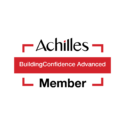Camps Viaduct: Vital Upgrades
Client: Story Rail
Value: £640,000
8 week program
Location: Motherwell, Scotland
Camps Viaduct is around 160 years old, 118 yards long and towers 35m above the River Clyde between Ferniegair and Motherwell and serves passengers travelling between Glasgow and Motherwell.
The project involved carrying out essential repairs to extend the lifespan of the structure as part of Network Rail’s commitment to running a safe and reliable railway. The whole project involved scour protection, de-veg piers, steelwork shot blasting and re-painting.
Kaymac’s involvement saw us undertaking the temporary works and bespoke access design and installation to enable us to carry out the permanent work; de-veging to the inner piers above and below the waterline and scour protection installation in the form of rock armour around both bridge abutments.
Key Challenges
- Deepwater levels
- Working in close proximity to other contractors
- Access constraints
The work was carried out near other contractors, that were working directly above us carry out metalwork repair work, before removing the old paint and rust and then priming and re-painting the bridge.
Due to unexpected delays, the timeline slipped, and therefore access that was originally planned and permitted could no longer be granted. This meant our team had to operate on night shifts to avoid working directly below the specialist steel repair contractors.
Solution
- Night-time working and a stringent work programme to meet clients’ deadlines
- Bespoke temporary access solution
- Environmental mitigations measures
- A team of multi-skilled divers and civil operatives
Temporary works
Kaymac engineers designed and developed a temporary access bridge with a load capacity capable of managing an excavator and a 5ton dumper loaded with D50 Rock Armour. The access bridge would stay in position throughout the project to provide access across the river to furthest span for essential embankment and scour repairs to be carried out.
The temporary access bridge was constructed from modular steel shallow-drafted NATO pontoons and fitted with five spud legs along the length of the bridge on the downstream side to ensure the bridge would stay in situ.
The team constructed bespoke temporary KayDams around the working area to create a safe working environment for operatives and environmental protection to monitor and control any sediment disturbed during the construction stage and avoid contamination into the watercourse. Before any work commenced within the containment bund, a fish rescue operation was carried out within the dammed area.
Permanent works
The embankment had an elevation change of approximately 3.5m across the width of the pier structure and the embankment level then continued to gradually rise in the direction of pier 5. With this notable elevation increase, the enabling and temporary works to allow the excavation and construction of the proposed scour protection system needed to be very robust. The team excavated to the required level and placed 600 tons of D50 Rock armour on the riverbanks and around the bridge’s abutments to provide a robust scour protection solution and prevent erosion.
To the centre piers, using a combination of diving operations and working from floating platforms, the team scraped out the joints, re-pointed and carried out the essential masonry repairs to all the piers.
“This essential work will not only greatly improve the look of the structure but will extend its lifespan for up to two decades.
Whilst the delivery elements of the project were nothing new to the core services Kaymac provide, the successful delivery of this project distinctively highlighted our ability to adapt, be reactive, fluid in our operations to suit the needs of our clients and the environment.












